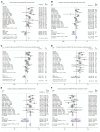Pertinence of glioma and single nucleotide polymorphism of TERT, CCDC26, CDKN2A/B and RTEL1 genes in glioma: a meta-analysis
- PMID: 37746290
- PMCID: PMC10512948
- DOI: 10.3389/fonc.2023.1180099
Pertinence of glioma and single nucleotide polymorphism of TERT, CCDC26, CDKN2A/B and RTEL1 genes in glioma: a meta-analysis
Erratum in
-
Erratum: Pertinence of glioma and single nucleotide polymorphism of TERT, CCDC26, CDKN2A/B, and RTEL1 genes in glioma: a meta-analysis.Front Oncol. 2024 Mar 11;14:1393063. doi: 10.3389/fonc.2024.1393063. eCollection 2024. Front Oncol. 2024. PMID: 38529370 Free PMC article.
Abstract
Background: Previous genetic-epidemiological studies considered TERT (rs2736100), CCDC26 (rs4295627), CDKN2A/B (rs4977756) and RTEL1 (rs6010620) gene polymorphisms as the risk factors specific to glioma. However, the data samples of previous genetic-epidemiological studies are modest to determine whether they have definite association with glioma.
Method: The study paid attention to systematically searching databases of PubMed, Embase, Web of Science (WoS), Scopus, Cochrane Library and Google Scholars. Meta-analysis under 5 genetic models, namely recessive model (RM), over-dominant model (O-DM), allele model (AM), co-dominant model (C-DM) and dominant model (DM) was conducted for generating odds ratios (ORs) and 95% confidence intervals (CIs). That was accompanied by subgroup analyses according to various racial groups. The software STATA 17.0 MP was implemented in the study.
Result: 21 articles were collected. According to data analysis results, in four genetic models (AM, RM, DM and C-DM) TERT gene rs2736100 polymorphism, CCDC26 gene rs4295627 polymorphism, CDKN2A/B gene rs4977756 polymorphism and RTEL1 gene rs6010620 polymorphisms increased the risk of glioma in Caucasians to different degrees. In Asian populations, the CCDC26 gene rs4295627 polymorphism and CDKN2A/B gene rs4977756 polymorphism did not exhibit a relevance to the risk of glioma. It is suggested to cautiously explain these results as the sample size is small.
Conclusion: The current meta-analysis suggested that the SNP of TERT (rs2736100), CCDC26 (rs4295627), CDKN2A/B (rs4977756) and RTEL1 (rs6010620) genes in glioma might increase risk of glioma, but there are ethnic differences. Further studies evaluating these polymorphisms and glioma risk are warranted.
Keywords: genetic model; glioma; meta-analysis; risk; single nucleotide polymorphism.
Copyright © 2023 Wu, Zhou, Zhang, Tang, Chen, Huang, Liu, Chen and Wang.
Conflict of interest statement
Author LH was employed by ICON Plc. The remaining authors declare the research was conducted in the absence of any commercial or financial relationships that could be construed as a potential conflict of interest.
Figures





Similar articles
-
Replication of GWAS identifies RTEL1, CDKN2A/B, and PHLDB1 SNPs as risk factors in Portuguese gliomas patients.Mol Biol Rep. 2020 Feb;47(2):877-886. doi: 10.1007/s11033-019-05178-8. Epub 2019 Nov 12. Mol Biol Rep. 2020. PMID: 31721021
-
Association between glioma susceptibility loci and tumour pathology defines specific molecular etiologies.Neuro Oncol. 2013 May;15(5):542-7. doi: 10.1093/neuonc/nos284. Epub 2012 Nov 16. Neuro Oncol. 2013. PMID: 23161787 Free PMC article.
-
An Updated and Comprehensive Meta-Analysis of Association Between Seven Hot Loci Polymorphisms from Eight GWAS and Glioma Risk.Mol Neurobiol. 2016 Sep;53(7):4397-405. doi: 10.1007/s12035-015-9346-4. Epub 2015 Aug 5. Mol Neurobiol. 2016. PMID: 26243184
-
Genetic advances in glioma: susceptibility genes and networks.Curr Opin Genet Dev. 2010 Jun;20(3):239-44. doi: 10.1016/j.gde.2010.02.001. Epub 2010 Mar 6. Curr Opin Genet Dev. 2010. PMID: 20211558 Free PMC article. Review.
-
CCDC26 rs4295627 polymorphisms associated with an increased risk of glioma: A meta-analysis.Adv Clin Exp Med. 2017 Nov;26(8):1275-1281. doi: 10.17219/acem/68067. Adv Clin Exp Med. 2017. PMID: 29264887 Review.
Cited by
-
Genetic Risk Factors and Clinical Outcomes in Childhood Eye Cancers: A Review.Genes (Basel). 2024 Feb 22;15(3):276. doi: 10.3390/genes15030276. Genes (Basel). 2024. PMID: 38540335 Free PMC article. Review.
-
Association of RAN and RANBP2 Gene Polymorphisms With Glioma Susceptibility in Chinese Children.Cancer Rep (Hoboken). 2024 Jul;7(7):e2136. doi: 10.1002/cnr2.2136. Cancer Rep (Hoboken). 2024. PMID: 39041645 Free PMC article.
References
-
- Bell EH, Zhang P, Fisher BJ, Macdonald DR, McElroy JP, Lesser GJ, et al. . Association of MGMT promoter methylation status with survival outcomes in patients with high-risk glioma treated with radiotherapy and temozolomide: an analysis from the NRG oncology/RTOG 0424 trial. JAMA Oncol (2018) 4:1405–9. doi: 10.1001/jamaoncol.2018.1977 - DOI - PMC - PubMed
Publication types
LinkOut - more resources
Full Text Sources
Miscellaneous

